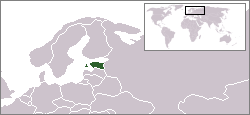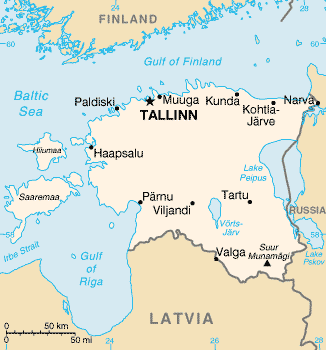Estonia
The Republic of Estonia is a small country in Northern Europe, bordering the Baltic Sea to the west and the Gulf of Finland to the north, and sharing a land border with its fellow Baltic state Latvia to the south and with Russia to the east.
| |||||
| National motto: None | |||||
 | |||||
| Official language | Estonian | ||||
| Capital | Tallinn | ||||
| President | Arnold Rüütel | ||||
| Prime Minister | Juhan Parts | ||||
| Area - Total - % water | Ranked 129th 45,226 km² 4.56% | ||||
| Population - Total (2003) - Density |
Ranked 150th 1,408,556 31/km² | ||||
| Independence - Declared - Recognised |
From Russia 24 February 1918 2 February 1920 | ||||
| Currency | Estonian kroon | ||||
| Time zone | UTC +2 | ||||
| National anthem | Mu isamaa, mu õnn ja rõõm | ||||
| Internet TLD | .ee | ||||
| Calling Code | 372 | ||||
History
Main article: History of Estonia
Estonia has been populated by the native Finno Ugric Estonians since prehistory. It was first christianised when the German Sword Brethren and Denmark conquered the land by 1227. Subsequent foreign powers that controlled Estonia at various times included Denmark, Sweden, Poland and finally Russia.
Following the collapse of Imperial Russia after the October Revolution, Estonia declared its independence as a republic on 24 February 1918. Forcibly incorporated into the Soviet Union in June 1940, it regained its freedom on 20 August 1991 with the Singing Revolution and collapse of the Soviet Union. 20 August remains a national holiday in Estonia because of this.
Since the last Russian troops left on 31 August 1994, Estonia has been free to promote economic and political ties with Western Europe and outside, becoming a member of NATO on 29 March 2004. Estonia opened accession negotiations with the European Union in 1998 and joined on 1 May 2004.
Politics
Main article: Politics of Estonia
Estonia is a constitutional democracy, with a president elected by the parliament (elections every five years) and a unicameral parliament. The government or the executive branch is formed by the prime minister, nominated by the president, and a total of 14 ministers. The government is appointed by the president after approval by the parliament.
Legislative power lies with the unicameral parliament, the Riigikogu or State Assembly, which consists of 101 seats. Members are elected by popular vote to serve four-year terms. The supreme judiciary court is the National Court or Riigikohus, with 17 justices whose chairman is appointed by the parliament for life on nomination by the president.
Counties
Main article: Counties of Estonia
Estonia numbers 15 main administrative subdivisions. Due to the geographical and demographic size of these subdivisions, they are to be considered counties rather than states (Estonian: pl. maakonnad; sg. - maakond). Here is a list of them:
- Harju County (Estonian: Harjumaa)
- Hiiu County (Estonian: Hiiumaa)
- Ida-Viru County (Estonian: Ida-Virumaa)
- Järva County (Estonian: Järvamaa)
- Jõgeva County (Estonian: Jõgevamaa)
- Lääne County (Estonian: Läänemaa)
- Lääne-Viru County (Estonian: Lääne-Virumaa)
- Pärnu County (Estonian: Pärnumaa)
- Põlva County (Estonian: Põlvamaa)
- Rapla County (Estonian: Raplamaa)
- Saare County (Estonian: Saaremaa)
- Tartu County (Estonian: Tartumaa)
- Valga County (Estonian: Valgamaa)
- Viljandi County (Estonian: Viljandimaa)
- Võru County (Estonian: Võrumaa)
Geography
Main article: Geography of Estonia

Between 57.3 and 59.5 latitude and 21.5 and 28.1 longitude, Estonia lies on the eastern shores of the Baltic Sea on the level northwestern part of the rising east European platform. Average elevation reaches only 50 m.
Oil shale (or kukersite) and limestone deposits, along with forests which cover 47% of the land, play key economic roles in this generally resource-poor country. Estonia boasts over 1,400 lakes (most very small, with the largest, Lake Peipsi, being 3,555 km²), numerous bogs, and 3,794 kilometers of coastline marked by numerous bays, straits, and inlets. The number of islands and islets is estimated at some 1,500 with two large enough to constitute their own counties, Saaremaa and Hiiumaa.
Its highest point is the Suur Munamägi in the southeastern corner of the country (318 m).
Economy
Main article: Economy of Estonia
As a member of the European Union, Estonia is part of the world's largest economy. In 1999, Estonia experienced its worst year economically since it regained independence in 1991, largely because of the impact of the August 1998 Russian financial crisis. Estonia joined the WTO in November 1999 - the second Baltic state to join - and continued its EU accession talks. Privatization of energy, telecommunications, railways, and other state-owned companies is a continuing process. Estonia completed most of its preparations for EU membership by the end of 2002 and now has one of the strongest economies of the new members states of the European Union, which Estonia joined on 1 May 2004. The Estonian economy is growing fast, partly due to a number of Finnish companies relocating their routine operations, and has a strong IT sector. GDP PPP is at $12,300, the highest in the Baltic states.
Demographics
Main article: Demographics of Estonia
About two thirds of the population consist of Estonians, with the rest from other former Soviet republics, mainly Russia, who predominantly live in the capital Tallinn. There is also a small group of Finnish descent.
The country's official language is Estonian, which is closely related to Finnish. Russian is also widely spoken.
Ethnicity
According to a census untertaken in 2002, the Estonian people are:
- 65.1 % Estonians
- 28.1% Russians
- 2.5% Ukrainians
- 1.5% Belorussians
- 0.9% Finns
Religion
Traditional religion of the Estonians is the Christian belief in the form the Evangelical Lutheran confession (as in many other countries in Scandinavia).
Less than a third of the population define themselves as believers, of those the majority are Lutheran, whereas the Russian minority is Eastern Orthodox. Ancient equinoctial heathen traditions are held in high regard.
Today, about 32 % of the population are members of a church or religious group, thereof:
- 14.8 % Estonian Evangelical Lutheran Church
- 13.9 % Orthodox
- ca. 6,000 Baptists
- ca. 3,500 Roman-Catholics
There are also a number of smaller Protestant and Jewish groups.
Language
The Estonian language, together with Finnish, and Hungarian forms a language group called Finno-Ugric languages.
All three combined, as well as Basque, are linguistically unrelated to what linguists call the Indo-European language family, which includes Germanic languages (like German, English, Swedish, Danish, ..), and, for example, Romance languages (like Italian or Spanish).
This unrelatedness makes it difficult for Indo-European langauage users to learn and understand the Estonian language (and vice versa).
Culture
Main article: Culture of Estonia
Miscellaneous topics
- Communications in Estonia
- Transportation in Estonia
- Military of Estonia
- Foreign relations of Estonia
- Tourism in the Baltics
- List of cities in Estonia
- List of municipalities in Estonia
- Crime in Estonia
- The Estonian State Decorations
- List of people on stamps of Estonia
- Public holidays in Estonia

